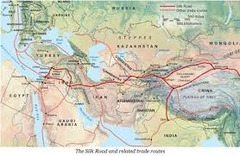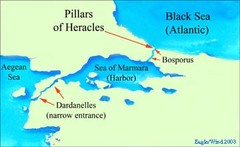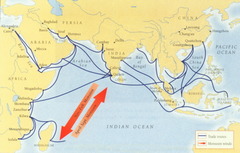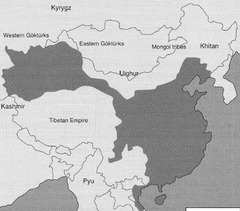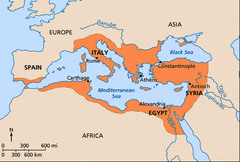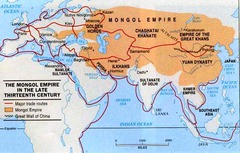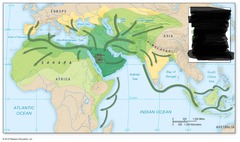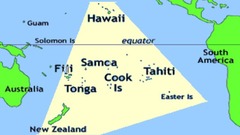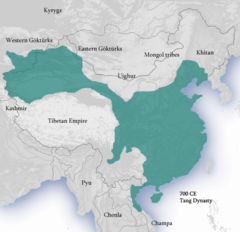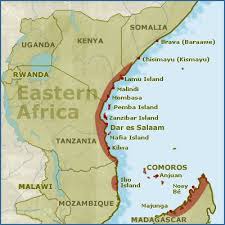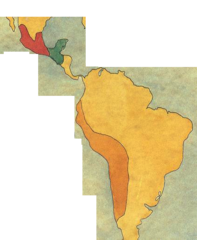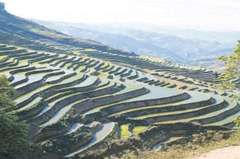3.1.1.A (SRN) Silk Road Network
- Focus on luxury items (silk, etc.), weight to value ratio was low.
- Diffused important technologies such as paper-making and gunpowder.
- Spread disease (Black Death)
- Transformed by technological and political developments.
- Declined with the crash of classical empires.
- Merchants were more likely to experience safe travel.
3.1.1.A (SRN) Qadis
- Courts and Islamic jurists, presided over legal and trade disputes.
- Indian, Armenian, Christian and Jewish merchants alike took advantage of Muslim legal protection.
3.1.1.A (SRN) Yassa
- The Mongol code of law; imposed strict punishments on those disturbing trade.
3.1.1.A. (SRN) Black Death (Bubonic Plague)
- Spread from Asia to Western Europe killing about one third of the people there.
3.1.1.A. (SRN) Sharia law
- Gave protection to merchants; was established across the Dar al-Islam.
3.1.1.A. (SRN) Islamic Abbasid Caliphate
- Rise would invigorate trade along it once again.
3.1.1.A. (SRN) Mongol Empire
- The rise boosted, and placed the Silk Road Network under one administrative empire.
- The rule of the Mongols in Central Asia coincided with the peak of it's trade.
3.1.1.A. Mediterranean Network
- Saw its peak of trade under the height of the Roman Empire; declined when Rome weakened.
- The spread of Islam and continuation of Roman civilization in the Byzantine Empire would revive trade.
- The religion of Islam had a positive impact on trade.
- Precious gems and perfumes from India, along with olive oil and glassware traded.
3.1.1.A. (MN) Sharia Law, Qadis & Courts, High regard Islam holds merchants.
(Muhammad was a merchant)
- All led to an increase of commercial activity where Islam had a significant presence.
3.1.1.A. (MN) Muslim & Jews
- Established trading firms in Cairo which benefited from the lucrative trade in silk yarn and cotton textiles.
3.1.1.A. (MN) Cairo and Alexandria
- Egyptian cities, now under Muslim rule, became powerful commercial centers of the Mediterranean network.
3.1.1.A. (MN) Black Sea
- A major portion of the Silk Roads ended on the this sea, where goods would be loaded onto ships and carried through the Bosporus into the Mediterranean.
3.1.1.A. (MN) Constantinople
- Capital of the Byzantine Empire, became an important hub of trade - its location is between Europe and Asia.
- City's control of trade provoked the jealousy of the merchants of Venice (powerful city of commerce).
3.1.1.A. (MN) Venetian Merchants
Helped steer the Fourth Crusade toward Constantinople in order to gain a larger share of this trade.
3.1.1.A. (TSN) Trans-Saharan Network
- Islam played a primary role in the increase of trade.
- Islam spread to sub-Saharan portions of west Africa.
- Empires emerged under the Sarah desert, in large part because Islam brought the means to empower local kings and provide a point of unity.
3.1.1.A. (TSN) Umayyad Caliphate
- Islam came to north Africa and reinvigorated trade
3.1.1.A. (TSN) Caravan Crossings (Sahara Desert)
- Increased the trade in gold, salt, ivory and slaves.
3.1.1.A. (TSN) Mansa Musa's Pilgrimage
- His pilgrimage to Mecca gave his kingdom of Mali wide recognition across the Dar al-Islam and served to increase trade connections across the Sahara.
3.1.1.A. (ION) Indian Ocean Network
- Dominate network of trade (Despite other network growths)
- Ideal network for exchanging bulk items, such as timber, ivory, spices, cotton textiles, and other things that would be difficult to move on land routes.
- Continued to be free from the domination of any state or empire. Seas were open to all merchants.
- Volume of exchange increased
- The coming of Islam played a significant role in the increase.
- New maritime technologies increased participation, facilitated navigation, and removed some of the risks of maritime trade.
3.1.1.A. (ION) Environmental Conditions
- Merchants had to consider Monsoon winds while scheduling their departures.
- Port cities along the rim of the Indian Ocean at any given time had large numbers of non-citizens waiting for changes in the monsoon winds.
- Cities were cosmopolitan and exuded a great deal of cultural tolerance.
3.1.1.A. (ION) Swahili Coast
- Muslim city-states along this east African coast contributed enormously to maritime trade.
- Gold, ivory, and exotic animals made their way from sub-Saharan and southern Africa to these cities,.
- Islam followed the path of goods, making converts across the network, particularly southeast Asia.
3.1.1.A. (ION) Malay Peninsula
- In southeast Asia, the Buddhist kingdom of Srivijaya thrived spice trade that flowed through the straits of Malacca.
- Srivijaya became an important kingdom for the diffusion of Buddhism across the region.
3.1.1.A. (ION) Song Dynasty
- Chinese maritime trade exceeded Silk Road trade, and Chinese porcelain has been found as far away as the Swahili coast of Africa.
3.1.1.A. (ION) New Maritime Technologies
- Chinese introduced the compass and massive trading ships called Junks which were able to carry larger cargoes.
- Arabs popularized the Dhow ship which was able to tack against the wind because of its advanced lateen sail.
- An instrument called the astrolabe allowed skilled sailors to determine their latitude at sea.
3.1.1.A. (Cities) Major Trade Cities
- Novgorod (Northern Russia)
- Malacca (Southeast Asia)
- Timbuktu (Sahara Africa)
- Hangzhou (South China)
3.1.1.A. (Cities) Novgorod
- Vital in connecting European merchants with their Arab and Byzantine counterparts.
- Its surrounding marshes and thick forests protected it from the Mongol conquests allowing its importance for the coveted trade in fine furs to be uninterrupted.
3.1.1.A. (Cities) Malacca
- Became an important city in the spice trade.
- It was a collection point for spices grown on tiny islands across Indonesia.
- The city's location on the straits of Malacca allowed it to collect tolls and control passage.
3.1.1.A. (Cities) Timbuktu
- Location on the southern rim of the Sahara Desert raised its importance for trans-Saharan caravan trade.
- It became an exchange point for west African gold and north African salt.
- Because of the trade in books, the city also became an important city for Islamic scholarship and education.
3.1.1.A. (Cities) Hangzhou
- Located near China's southern coast and on the Grand Canal which connected it across 1000 kilometers to Beijing.
- It was a departure point for Chinese goods to Korea, Japan, southeast Asia, and the Indian Ocean trade network.
- It became the capital of China during the Southern Song Dynasty.
3.1.1.B (AN) Americas Networks
- Mesoamerica and the Andes regions developed extensive trade networks.
- By and large the Aztec, Maya and Incas did not have major maritime trade.
- The most sophisticated road system was constructed by the Inca and spans a total of 25,000 miles.
- Transregional trade occurred.
- Basically took place within a barter system, Aztecs sometimes used cacao beans as a form of currency.
3.1.1.B (AN) Amerindians
- Created an elaborate system of roads which they used for travel, trade, and to move their armies.
3.1.1.B (AN) Pueblos
- Mesoamericans traded with them, whom lived in what is now New Mexico and Arizona.
3.1.1.C (LG) Luxury Goods
- The significant increase in luxury trade was the result of several factors. The creation of Mongol Khanates and the Islamic Caliphates along with the reconstitution of a powerful centralized state in China were certainly major factors.
- In most areas, improved techniques of production, innovations in transportation, and new commercial practices impacted the surge in luxury goods during this period.
- Goods include Porcelain, Silk, Spices
- Trade in luxury goods was also facilitated by innovations in forms of credit and economic exchange.
- From Arabs, the practice spread to Western Europe where Italian merchants advanced this method into bills of exchange.
3.1.1.C (LG) China's Tang Dynasty
- Government standardized the production of porcelain.
- Production spread from northern China to the south as high quality kaolin clay was discovered there.
- No one could match the quality of Chinese porcelain in this period.
3.1.1.C (LG) Silk
- Most coveted luxury goods in this period.
- Although its methods would be duplicated and it would lose its exclusive monopoly of production, China's silk remained the standard of quality throughout this era.
- During the Sui and Tang dynasties, the state directly oversaw the production of silk and attempted to keep it a state secret.
- The quantity of silk produced in China, as well as in the Byzantine Empire and other states in Asia, increased tremendously.
3.1.1.C (LG) Spices
- Comprised an essential element of the trade in luxuries.
- Saffron had a higher value to weight ratio than silk, but in the world of spices, black pepper was king.
- Pepper from India had become a household possession of the rich.
- Pepper helped food taste better, but it was also thought to have medicinal and preservative powers.
3.1.1.C (LG) Caravan Routes/Caravanserai
- Innovations in transportation networks also led to increased exchanges in luxury items.
- Sparse water, extreme temperatures, deserts and rugged mountains made the crossing between China and the western termini of the Silk Roads nearly impossible for individual travelers.
- Much of this territory was out of the control of most governments. Banditry was rampant. Thus merchants would only trade in lightweight high-profit luxury items that made the risks of the journey worthwhile. Only in caravans travelling familiar routes could a merchant or traveler hope to survive in this environment.
- Nomadic people settled at frequent stopping points to offer services to merchants. This practice led to the development of fortified inns for weary travelers called caravanserai.
- The camel saddle, along with new breeding techniques, greatly increased the volume of luxury goods moving across Eurasia.
3.1.1.D (CG) Commercial Growth
- State benefited to promote trade and one area they effect in doing was the issuing of currency as a medium of exchange.
- The earliest form of trade was simple bilateral exchanges between two parties (Bartering), but slowed trade by limiting the number of possible connections between traders.
- Finding a medium of exchange--something that both parties desired, such as bolts of silk, precious metals or gems--allowed transactions to occur more frequently.
- The next step would be for a state to issue an official medium of exchange, or currency, whose legitimacy they would back up.
- In China, the government issued tokens of brass or copper that could be used to buy most anything and could be taken as a form of payment, but the amount of coins needed for large purchases could be bulky and dangerous to transport. The Chinese solved this problem by creating small pieces of paper with pictures of the coin printed on the front. (Paper currency)
3.1.1.D (CG) Grand Canal
- States could also take on massive engineering projects to increase trade.
- Rivers are nature's highways and were the most effective means of getting goods from one place to another.
- The Sui emperor Yangdi ordered the building of the Grand Canal.
- By connecting lakes and smaller canals already in place, it became possible for barges to transport to transport tons of grain from the Yangzi river region in the south all the way to the area of Beijing.
- The northern border, whose weakness had made the Han so vulnerable, was now able to have stronger fortifications.
- Large granaries were built, one of which held 3.3 million bushels
3.1.1.D (CG) Hanseatic League
- Formed on the northern shore of Western Europe as a more organized alliance of commercial cities.
- It included cities from London to Novgorod Russia, and many in between along the North and Baltic Seas.
- The League was established to protect trade between member cities.
- It had is own court system to settle disputes and could summon military force to protect any of its members.
3.1.1.E (E) China (Tang Dynasty)
- Tang emperor sent several military expeditions to the northwest (border defense against nomads, particularly the Turks, but also to take control western trade routes)
- Expansion brought in more ethnic diversity.
- Chang'an became intensely cosmopolitan. Served as both the eastern terminus of the Silk Roads and the northern end of the Grand Canal.
- By the 9th century, Uighurs dominated money lending, Sogdians ran the popular imported wine shops, and Turks were involved in the trade of many goods and Buddhist relics.
3.1.1.E (E) Byzantine Empire
- The expansion of the empire broadened the groups of people participating in commerce.
- Trade connected Constantinople with commercial cities such as Alexandria and Tripoli as well as the islands of Crete and Sicily.
- When the Italian city-states emerged, they depended on imports of grain and textiles coming in from the empire.
- The Empire also served as an important connection between Mediterranean trade and the Arab world.
3.1.1.E (E) Mongols
- Genghis Khan conquered one of the largest land empires in history.
- When the conquests were done the entire length of the Silk Roads was in their domain and they settled down and enjoyed the benefits of trade.
- Trade flourished under the protection of a flexible legal system and diplomatic protocols.
- They encouraged the building of port cities such as Kaffa on the Black Sea.
- They pushed trade outside of their empire by forcing Chinese to emigrate to South East Asia and form merchant communities in the trading ports there.
- In Cambodia, Vietnam, the Malay peninsula and Java, Chinese diaspora communities connected Mongol trade routes to foreign trading ports of the Indian Ocean network.
3.1.1.E (E) Islamic Caliphates
- Pro-trade from the beginning (Mohammed was a merchant) and trade accounted in part for the rapid spread of the faith.
- Merchants traveled farther than armies and took their religion to remote areas of Eurasia.
- As new areas were incorporated into the Dar al Islam, its protective legal system and positive acceptance of merchants created welcome haven of exchange.
- The trans-Saharan trade in salt took Islam to West Africa thus bringing the Sub-Saharan region into Afro-Eurasian networks.
- Islam diffused to the Africa's Swahili Coast.
- In South East Asia, the port city of Malacca became an Islamic Sultanate and remained so until the Portuguese showed up.
3.1.2.A (TE) Trade Expansion
- Technological adaptions to environmental conditions helped merchants expand and intensify trade.
- By minimizing geographical barriers to the flow of commerce, long-distance trade made greater connections across regions.
- The geographic reach given to the Vikings by their longships intensified trade.
- Camels greatly intensified trade
- With the added legal protection of Islamic law, Trans-Saharan flourished, some caravans consisted in as many as twelve thousand camels
3.1.2.A (TE) Viking Longship
- Vikings began to leave their home.
- The migrations of the Norsemen were made possible by a remarkable vessel.
- Its nearly forty foot wide sail could catch the North Sea's winds and drive it with great speed.
- In the absence of wind the boats could be propelled by oars.
- The movement of the Vikings had an impact on commerce.
- Their expansion connected several regional trading zones in Eurasia by linking Byzantine, Islamic, Northern European, and Central Asian routes via the Russians.
3.1.2.A (TE) Camels
- Well adapted to the arid environments.
- The Persians first introduced the camel to Egypt, but it did not thrive well in the fertile Nile valley.
- It was the Berber tribes of North Africa who made the most of this imported animal.
- Camels allowed the Berbers to organize regular caravan crossings of the Sahara Desert. These crossings had occurred for centuries but they were sporadic and periodic.
- Gold from West Africa made the potential profits so high that merchants were willing to take the risks.
3.1.2.B (M) Migration
- The movement of people had environmental effects. New tools and crops are carried on the backs of migrations and these can't help but alter man's relationship to the land.
3.1.2.B (M) Bantu Migration
- Disseminated iron making technology across the continent.
- Sharp iron tools made reaping of crops much faster allowing more to be grown.
- Some parts of Sub-Saharan Africa experienced demographic changes.
- Making use of bananas, which were first brought to east Africa by Polynesian people, Bantu populations increased.
- To meet the needs of growing populations, Bantu speaking people turned to irrigation and terracing techniques and experienced the associated environmental effects.
- Land was cleared and erosion took place at a greater rate.
3.1.2.B (M) Polynesian Migration
- From their origins in East Asia, probably Taiwan, Polynesians spent several centuries "island hoping" to Fiji, Somoa, and Tahiti.
- Eventually reached the Hawaiian Islands.
- After learning to navigate with the stars and perfecting canoe building, their reach extended thousands of miles to complete the Polynesian Triangle, an imaginary triangle with Hawaii, New Zealand, and Easter Island forming its corners.
- Without a written language or the use of metals, they formed complex hierarchical societies.
- Animals taken by the migrating Polynesians had significant environmental consequences
3.1.2.C (LD) Langue Diffusion
- The movement of people in this era also led to the diffusion of languages.
- For example, the languages inside the Polynesian Triangle all developed from the base Polynesian language.
- Likewise, the linguistic impact of the Bantu migration is evident in the fact that in Africa, both north and south of the equator, over 300 languages are spoken that belong to the Bantu linguistic family.
- Many scholars believe that Swahili, the language of east Africa, is a blend of Bantu with Arabic.
- Arabic also spread during this time period, primarily as result of the rapid and extensive spread of Islam.
3.1.3.A (I) Islam
- Muhammad Saw visions, later told them and would be called the Quran.
- Most of his preaching focused on the emerging economic inequalities around Mecca; it was wrong, he insisted, on building a private fortune rather than helping out the poor.
- Purpose was to establish social justice on earth; their first duty was to build "a community characterized by practical compassion, in which there was a fair distribution of wealth. This was far more important than any doctrinal teaching about God."
- It was strongly influenced by religions that had made their way into Arabia and by those it came in contact with as it spread.
- Cross-cultural encounters between these religions and the Arabian Peninsula introduced the most prominent feature of Islam, its monotheism. Other influences were the ideas of an afterlife and final judgement, the belief in angels, a concept of the supernatural, and the embodiment of evil in the figure of Satan.
- Rapid spread from its place of origin into Byzantine provinces, North Africa, and even into Iberia (Spain).
- Military conquests were not the only way Islam spread.
3.1.3.A (I) Umayyad Caliphate
- Armies took the Byzantine city of Damascus and Jerusalem.
- To deprive the Byzantine Empire from grain and to secure a location for future conquests of North Africa, the Umayyads turned next to Egypt. Tripoli fell and all of North Africa within the next years.
3.1.4.A (DT) Dar al-Islam & Trade Routes
- There was continued diffusion of crops (bananas in africa, new rice varieties in E.Asia, spread of cotton, sugar, and citrus throughout
- The Mediterranean basin and pathogens, including epidemic diseases like the bubonic plague, along the trade routes.
3.2.1.A (ER) Empire Reconstruction
- States that reformed during this time period built upon the foundations of the classical ages.
- Sometimes called "second wind civilizations"
- Found traditional sources of authority as reliable ground for the reconstitution of their civilizations.
- These states had to combine these traditions with innovations in order to adapt to new circumstances.
3.2.1.A (ER) China (Tang/Sui/Song Dyansties)
- Reinstated the tradition of using a Confucian bureaucracy in China's political system.
- The Confucian civil service exams were brought back.
- Patriarchy continued to be a feature of Chinese.
- Developed tributary system and Equal Feild System.
- Chinese dynasties had long tried to project their control over the Korean peninsula; indeed, its long costly war with Korea did much to discredit the Sui Dynasty, the Tang's predecessor.
- The Tang Dynasty gave its support the the Silla family of Korea to ensure their rule over the entire Korean peninsula, but it cost the Silla their independence.
3.2.1.A (ER) Equal Field System
- Developed to prevent peasant land from falling into the hands of the aristocracy, which happens so often during hard economic times. In this system, the government owned all the land but periodically redistributed it to families.
3.2.1.A (ER) Tributary States
- Based on their belief that Chinese civilization was superior to others, but barbarian and non-Chinese people could have access to Chinese ways providing they ceremonially recognized the supremacy of China and paid tribute to the emperor.
3.2.1.A (ER) Kowtow
- Tradition of bowing head to ground in front of emperor
3.2.1.A (ER) The Byzantine Empire
- Commissioned the Code of Justinian
- Had an official religion, Orthodox Christianity.
- Beginning with Constantine and extending to the end of the empire, they operated under an ideology called Caesaropapism, the vesting of political and religious authority under a single figure.
- Thus the emperor, the political head of state, simultaneously acted as the head of the organized Church.
3.2.1.A (ER) The Byzantine Empire - Code of Justinian
- Justinian commissioned the formation of several bodies of law.
- The Code of Justinian gave order and security to a collection of diverse peoples across the breadth of the empire. Code enacted Christianity morality into Roman civil law. It enforced the Church's views on divorce, adultery and homosexuality, and the Church's property was protected as a permanent holding.
3.2.1.A (ER) Theme System
- Developed to counter the threat of Islamic barbarian invasions; a sytem of imperial organization.
- Each theme, or province, was placed under the leadership of a general who organized its administration and defense.
- The theme system provided incentives for increased grain production and gave the empire effective and loyal soldiers. Under this system the empire protected its eastern borders and captured additional land in Anatolia and present day Syria.
3.2.1.B (EG) Empire Governance
- New forms of governance emerged, including those developed in various Islamic states, the Mongol Khanates, new Hindu and Buddhist states in South, East and SE Asia; city-states, and decentralized government (feudalism) in Europe and Japan.
3.2.1.B (EG) The Islamic States
- As a result, Islam facilitated the rise of empires in areas once characterized by bands of feuding nomadic tribes.
- After the death of Mohammed, a dispute erupted over who should be the leader of this new religion. Since the idea of another prophet was inconceivable, a "deputy" or Caliph was chosen to lead the Muslim community. Disagreement over the qualifications of the Caliph led to the split of Muslims into Shia and Sunni factions.
- The Umayyad Caliphate pushed the boundaries of Islam far outside the Arabian peninsula. Umayyad armies conquered the Middle East, spread across North Africa, and into Iberia. Their conquests in Europe were limited to Spain by the Battle of Tours in which the Franks routed the Muslim armies and turned them back across the Pyrenees Mountains.
- The Umayyads were overthrown by the Abbasids and a new Caliphate was established. Under the Abbasid Caliphate a wider variety of cultural influences made their way into Islamic civilization, the most prominent of which was Persian.
3.2.1.B (EG) The Mongol Khanates
- The Mongols built the largest land empire in the world.
- Brought together by Genghis Kahn
- Had elaborate Military Organization
- Their equestrian skills were most effective on the battle field.
- Genghis Khan's armies first united the Mongol people, then began to incorporate other Asian tribes and Turks into his empire.
- Mongols sacked Baghdad and ended the Islamic Caliphate.
- Ruled Russia as a tributary state.
- Genghis Khan's grandson Kublai Khan established the Yuan Dynasty and ruled China directly.
3.2.1.B (EG) Genghis Khan
- Man responsible for uniting these warring tribes into an empire.
- Tactic - blur the lines between tribes by intermarriage.
- Important method of breaking tribal loyalties was through military organization.
- Destroyed the Seljuk Turks and paved the way for the rise of the Ottomans
- Ruled Russia as a tributary state.
3.2.1.B (EG) Military Organization: Arban->Zagun->Mingan->Tumen
- The most basic unit of the Mongol army; unit of 10 men
- To break the power of tribal identity, the men in each arban were purposely chosen from different bloodlines.
- A group of ten arbans formed an unit of 100 called a zagun
- Ten of these formed mingan, or battalion, of one thousand troops
- Ten of these were a tumen of ten thousand soldiers.
3.2.1.B (EG) Arrow Messenger
- Communication across the empire depended on a postal service made up of them.
- Delivered communications between stations set up approximately 20 miles apart.
3.2.1.B (EG) Yassa
- Imposed law which codified most aspects of politics and the daily life of the empire.
- Law granted religious toleration and protected trade. The breadth of the Empire encompassed the Silk Roads and trade began to flow again.
3.2.1.B (EG) Swahili Coast City-States
- Tade and Islam gave rise to powerful but independent city-states that thrived on Indian Ocean commerce
- Swahili is a language that formed through the blending of Bantu and Arabic.
- Highly tolerant and cosmopolitan.
- Because of the seasonal monsoons, at any given time these cities were occupied by many merchants of many faiths waiting for the winds to favor their departure.
- The Swahili city-states were important points for connecting inland trade into the vast Indian Ocean network.
3.2.1.B (EG) Kilwa
- Important was city, which was the farthest down the coast a merchant ship could sail in a typical monsoon season.
- Attracted trade from the southernmost part of Africa. With this outlet for gold and ivory, the powerful Great Zimbabwe formed in southern Africa.
3.2.1.B (EG) Fuedalism
- Rise in Western Europe and Japan.
- After the fall of the Western Roman Empire, nothing had really formed to replace the security provided by Roman civilization.
- The need for security was made clear when invaders began to came in.
- People looked to local landowners to provide them with protection and they in turn gave their labor to the landlord. (Core of feudalism)
- Usually included legally binding contract.
- To fulfill his obligation of protection the lord supported a military class known as knights.
- The labor of the serfs was a form of tax to the lord and they often were obligated to form small armies of foot soldiers as well
- Japan fell into a similar situation with samurai warriors comprising the military caste. (Difference - absence of negotiated contracts between vassals and their superiors)
3.2.1.C (SS) Synthesized States
- There were some states in this time period that blended traditions with previous or neighboring civilizations.
- Example: the Abbasid Caliphate was heavily influenced by Persian traditions.
- Another synthesized state in this era was Japan. T
- The government embarked on a course of transformation known as the Taika Reforms in which they copied many of China's successes.
- They attempted to centralize their state by means of a Confucian based bureaucracy. Chinese written language entered Japan, and the Japanese borrowed the Chinese equal field system of agriculture. Through Japan's connection to China, Buddhism poured into China, as it did in Korea and Vietnam.
3.2.1.D (AC) American City-States & Empires
- Most prominent: the Mayans (Red), Incas (Blue), and the Aztecs (Orange).
- These civilizations were made possible by massive agricultural surpluses that supported hierarchical and complex societies.
- Most important crop was maize (Corn) in Mesoamerica and potatoes in the Andes.
- Developed highly sophisticated irrigation and agricultural techniques to farm the harsh forests, lowlands, and mountains of their terrain. (Sometimes labeled "hydraulic" civilizations.)
3.2.1.D (AC) Mayans
- Learned to trap rich river silt with terraces to replenish the fertility of the thin, poorly drained topsoil of southern Mexico.
- The increased agriculture allowed the Mayan civilization to greatly expand, driving them to find increasingly creative means of collecting and storing water during the dry seasons and as insurance against unpredictable summer rains.
- Not a centralized empire, but rather organized into over fifty small city-kingdoms often competing against each other.
- Tikal, the most powerful of these city-kingdoms, lasted eight centuries.
- About fifty years before the Spanish showed up in the Americas, the Mayan civilization fell apart, probably due to civil wars between the city-states.
3.2.1.D (AC) Aztecs
- An ethnic group called the Mexica migrated southeast and eventually settled on an island in the marshy areas of Lake Texcoco.
- Built the settlement that would later become Tenochtitlan
- By raking the muck of the lake into small islands above the surface of the water (called chinampas), they were able to produce abundant agriculture to support a thriving civilization.
- The Aztec Empire was a loose collection of conquered areas from which the core at Tenochtitlan collected heavy tribute.
- Every year Aztec rulers demanded massive amounts of clothing, jewelry, food, animals, and other materials from locations across their vast domain.
- The expansion of the empire was motivated in part by its religious belief. The Aztec believed that their gods were engaged in an ongoing struggle against the stars. The keep the fight going, and keep the sun moving across the sky, the gods needed human blood that was provided by an elaborate ritual of mass human sacrifice.
3.2.1.D (AC) Incas
- Built the most centralized empire in the Americas during this time.
- Spread their civilization along the 2500 mile spine of the Andes Mountains on the western side of South America.
- Extensive terracing allowed them to practice agriculture in these high altitude and mountainous regions where they grew potatoes, maize, beans and peppers.
- There was a small merchant class, but trade was controlled by the government. U
- Practiced cultural imperialism, forcing their language and religion on conquered people.
- Centralized their rule through a complex bureaucracy and an extensive network of roads and bridges.
- Ruler was believed to be a god.
3.2.2 (CT) Tang China & the Abbasids
- As Tang China expanded westward they came in contact with the Dar al Islam.
- The Muslim Armies routed the Chinese and ended their westward advancement into Central Asia.
- Central Asia would be primarily Islamic; Buddhism would decline.
- According to legends, knowledgeable Chinese prisoners of war were forced to teach the Muslim Abbasids the secrets of paper-making
3.2.2 (CT) Mongol Empire
- Islamic mathematics and astronomy spread from the Dar la Islam into China where they found a receptive audience.
- Kublai Khan was very interested in mathematics, such as algebra, which the Muslims had developed in Baghdad.
- Most instrumental in this exchange was Rashid al-Din, the scholarly connection between the great Mongol courts in Iran and China.
- The Pax Mongolia allowed for the transfer of grapes and fruit trees to China.
- Luxury items of Chinese cuisine, such as pepper, cinnamon and tea, were introduced into the Muslim world.
- Perhaps the most important technological transfers during the Pax Mongolia were block printing and gunpowder.
- Through the Mongols, block printing, which had developed during China's Song Dynasty, was transferred to the Muslim world.
- Best known technological exchange facilitated by the Mongols was gunpowder.
3.2.2 (CT) The Crusades
- The Crusades were a series of religious wars launched initially to route Muslims from the Holy Land (Jerusalem).
- Introduced Europeans to new and exotic lands and initiated a cultural and technological exchange.
- One-way transfer from the Dar al Islam to Western Europe. Muslim science and medicine was shown to be superior to that in Europe.
- Europeans borrowed the practice of making damascene swords from the Muslims.
- Important cultural transfer were Arabic numerals and the decimal system which helped Europeans develop advanced mathematics and more efficient accounting systems for trade.
- The game of chess as well as foods such as yogurt, coffee, sugar and dates were introduced in Europe because of the Crusades.
- Europeans were also introduced to their own cultural and intellectual past.
3.2.2 (CT) Zheng He
- The Chinese commissioned 7 major voyages under the leadership of admiral Zheng He.
- Zheng He set out to establish the reputation of the Ming in the Indian Ocean.
- These Chinese expeditions were not driven by attempts to conquer or win converts. They were diplomatic in nature, intended to impress upon others the prestige, wealth and superiority of Chinese civilization.
- Once other societies saw this, they would be willing to pay tribute to China for the right to purchase costly Chinese luxury products such as silk and porcelain.
- A change of power in imperial China brought these voyages to an end.
- A new emperor, under the influence of powerful Confucians long suspicious of these voyages, withdrew funds for these diplomatic missions.
3.3.1.A (AI) Agricultural Innovations
People used technology and techniques to deal with nature's deficiencies. By interacting with their environment in innovative ways, agricultural production soared, urban growth was supported, and societies became more stratified.
3.3.1.A (AI) Champa Rice
- The Tang Dynasty invaded Vietnam. There they discovered a variety of rice that ripens in less than 60 days. The Chinese transplanted this back to China where it increased the food supply by allowing two harvests in a single season
- Song Dynasty benefited the most from this
3.3.1.A (AI) Chinampa Field System
- In Mesoamerica the Aztecs turned shallow lakes into productive agricultural centers. By raking the muck from the bottom of the lake into mounds that rose above the surface, they could use these small fertile "islands" to grow crops.
- This allowed the marshy wetlands around Lake Texoco to be used for growing beans, maize, squash, peppers and tomatoes.
3.3.1.A (AI) Waru Waru System
- In the Andean areas of South America, the Peruvians developed this system of agriculture which was directly opposite of the chinampa system.
- Water supply was scarce and drought a consistent problem.
- The Peruvians raised beds of soil and collected fluvial water or rainwater around the beds to keep them irrigated and control erosion.
3.3.1.A (AI) Terracing
- Another technique used in the mountains of South America and East Asia
- The steep incline of a mountain side was sculpted into concentric flat platforms that allowed agriculture to be planted
3.3.1.A (AI) Three Field System
- Farmer would plant half of their land and let the other half recover from the previous year.
- To improve this situation, farmers devised this system.
- By dividing their land into thirds and rotating only one third fallow, farmers theoretically increased their efficiency to 67 percent.
- Adding to production increase was the use of iron plows and a harness that allowed several horses to be used simultaneous for power plowing.
